If you’re coming to Jordan, you will definitely be planning a Petra tour. However, finding a reliable and concise guide takes a lot of work. That’s especially unfortunate, considering there are over a million visitors every year, and it’s regarded as one of the New 7 Wonders of the World. No need to worry; we have you covered😉.
This article covers the 15 things we wished we knew before visiting Petra, including detailed interactive Petra maps including trails. We won’t go into the details of each and every monument, but we give you enough information to plan your visit to the Rose City, be it for a day or a week.
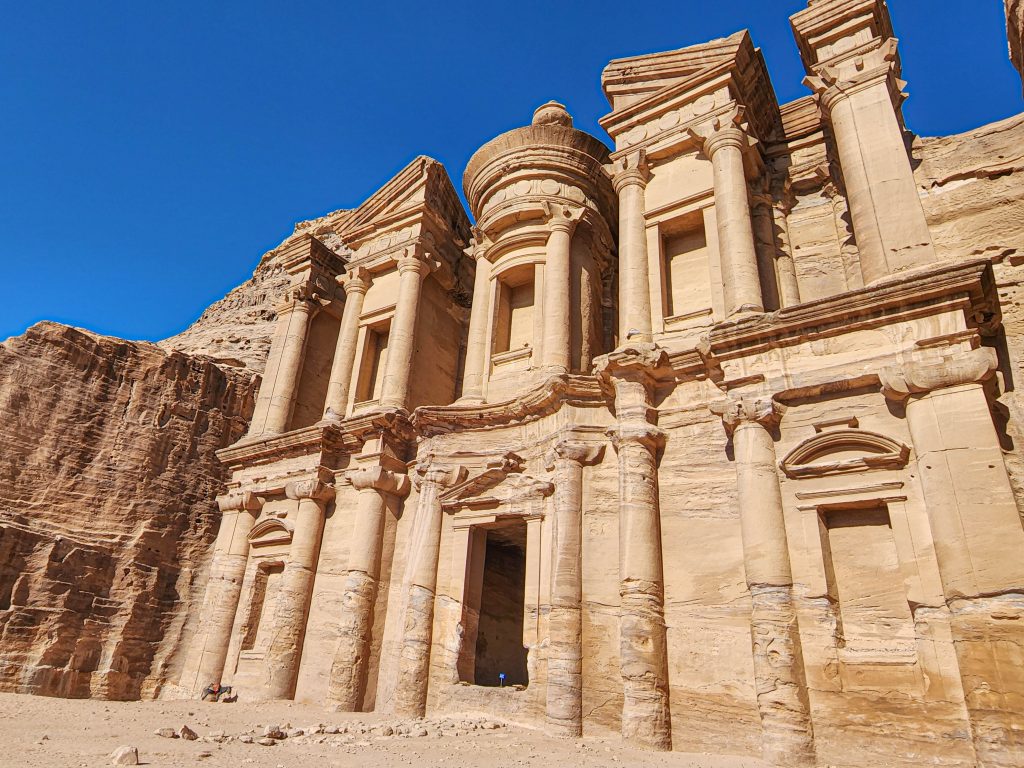
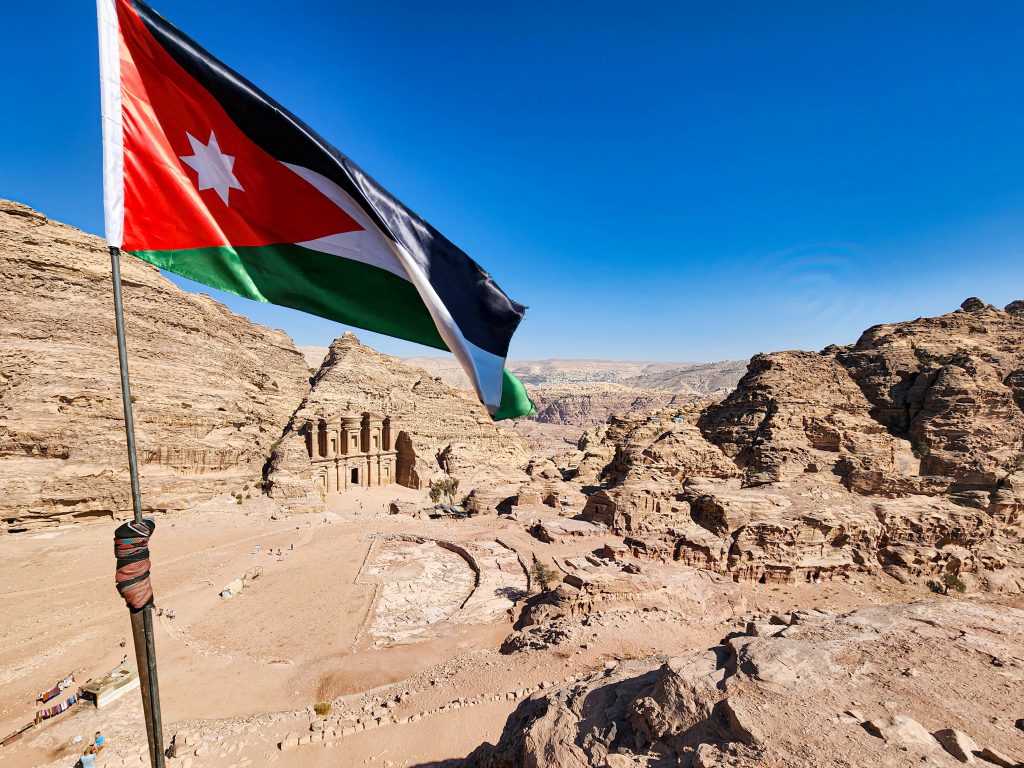
Table of Contents
What is Petra
Chances are, if you’re reading this article, you know that Petra was the capital of the Nabataean Arabs and is one of the most famous archaeological sites in the world. It’s a UNESCO World Heritage Site and one of the New 7 Wonders of the World.
People come to see the buildings carved from sandstone in relief, like the Treasury, which is why Petra is called the Rose City. You’ll learn about this ancient and powerful Nabataean Kingdom that rivaled the power of a Decapolis City. Like those cities, Petra remained an independent city-state during the Roman formation of Judea and only came under Roman rule 200 years later when the emperor Trajan annexed Arabia.
Jordan’s an ancient land with a rich history, but the modern history of Petra is equally as fascinating. The city was lost to Europeans until 1812 when Johann Ludwig Burckhardt found the valley inhabited by semi-nomadic Bedouins. That is why Petra is often called the Lost City. Archeological studies began in earnest in 1929 and continue today. Even after nearly a century of study, only five percent of the city has been uncovered, and many mysteries remain. The B’doul Bedouins still live in the valley and are the caretakers and guides of Petra, and are an integral part of the Petra experience.
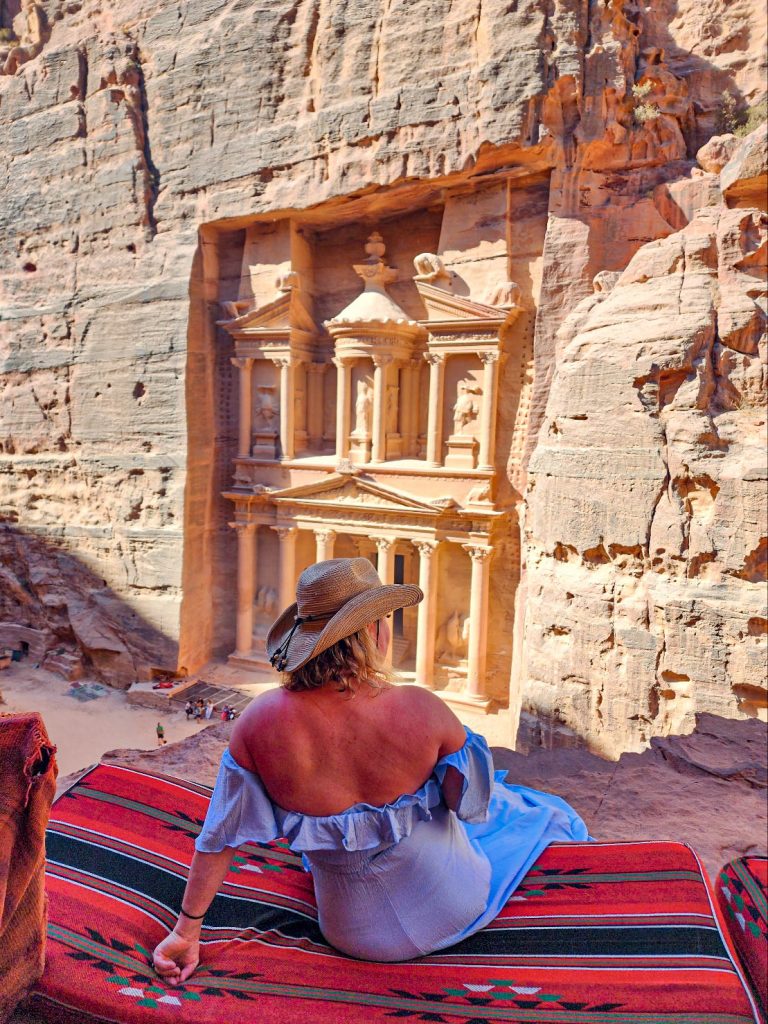
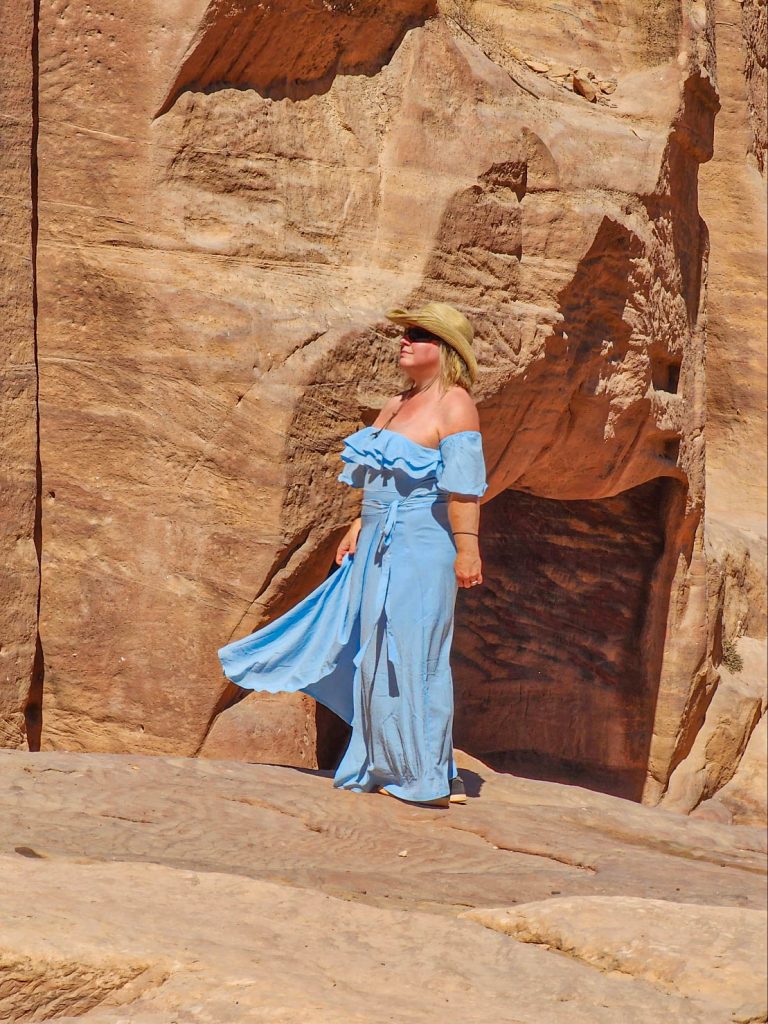
When is Petra Open (and when’s the best time to visit Petra)
Petra is open 365 days a year with slightly shorter winter hours. Petra at Night runs three days a week. Petra’s hours are as follows:
Petra Opening Hours
- 6:00 AM – 6:00 PM during the Summer
- 6:00 AM – 4:00 PM during the Winter
Petra At Night
- 8:30 PM -10:00 PM Monday, Wednesday, and Thursday
Spring is generally the best time to visit Petra, which is why it’s the high season in Jordan. The hot season lasts for 4.1 months, from late May to early October. October is a sweet spot to visit because most places are still running their summer operations, the heat is down and you aren’t fighting peak season crowds. For reference, the closest weather station is in Ma’An.
Winter is an interesting time to visit Petra, especially for photographers. There are fewer people (re: open frames) and generally better lighting. Shooting shadowy canyons with brightly lit skies is notoriously difficult and the subdued winter light really shows off the color in the sandstone.
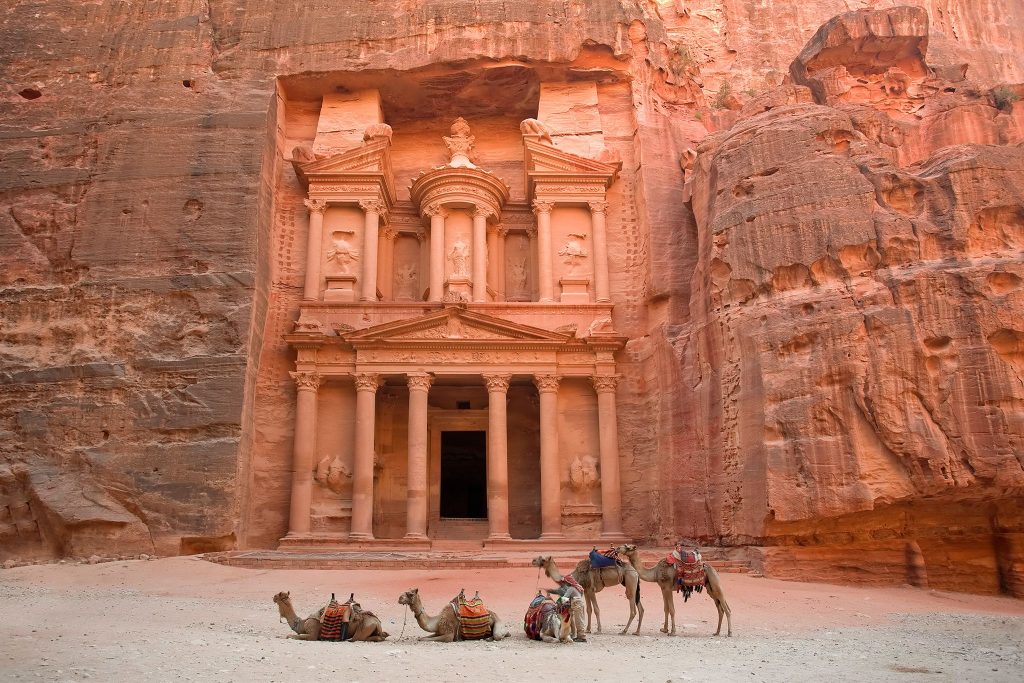
Is Petra Safe?
Petra is generally safe, but it’s still good to exercise reasonable caution. I found the Bedouin men extremely respectful, and courteous. This makes sense because they are in a tight knit devoutly religious community who rely on tourists for their income. The trails and climate do require some degree of caution.
For starters, you should wear comfortable shoes with a decent grip. The Nabatean stairs that climb out of the canyon are 2000 years old and certainly not up to OSHA standards. Also, it’s just plain hot in Petra, so follow our Petra packing guide and pace yourself, especially during the brutal heat of the day. Start early, wear sunscreen, and drink plenty of water. Also, be respectful (and cautious) wandering off the main trail. There’s a lot of empty desert around Petra, so getting a guide will increase your safety tremendously.
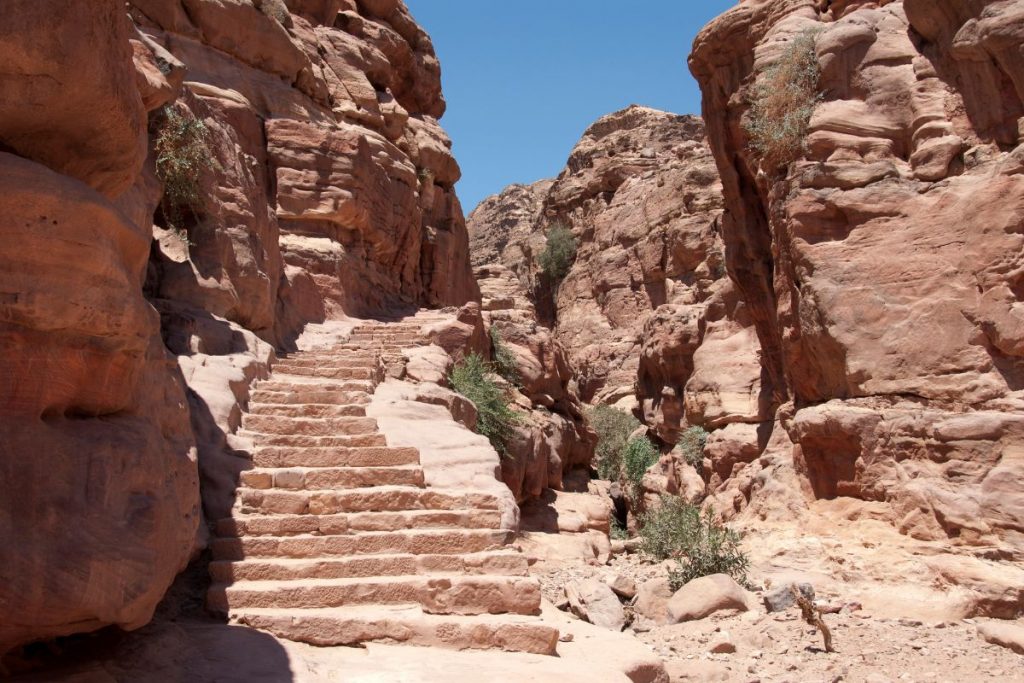
What Should I Pack for Petra?
Our Petra packing guide is basically what to pack for a day hike with a few extra items.
The essentials to pack for Petra are:
- Sunscreen (love this stick sunscreen so my hands stay grease free when shooting photos)
- Water
- Steripen (if you plan on refilling your water bottle)
- Paper money (cash is king for tipping, buying water, snacks, food, crafts. Some of the restaurants took cards, but everybody accepts cash)
- Sun protection (hat, lip balm, etc)
- Basic hiking kit (trekking pole (if you have one), moleskin, ibuprofen, etc)
- Camera (Petra is so pretty that you’ll want to remember it)-(This link is to my go-to camera😉)
- Digital maps (we have them, you might as well put them on your phone)
- Comfortable shoes
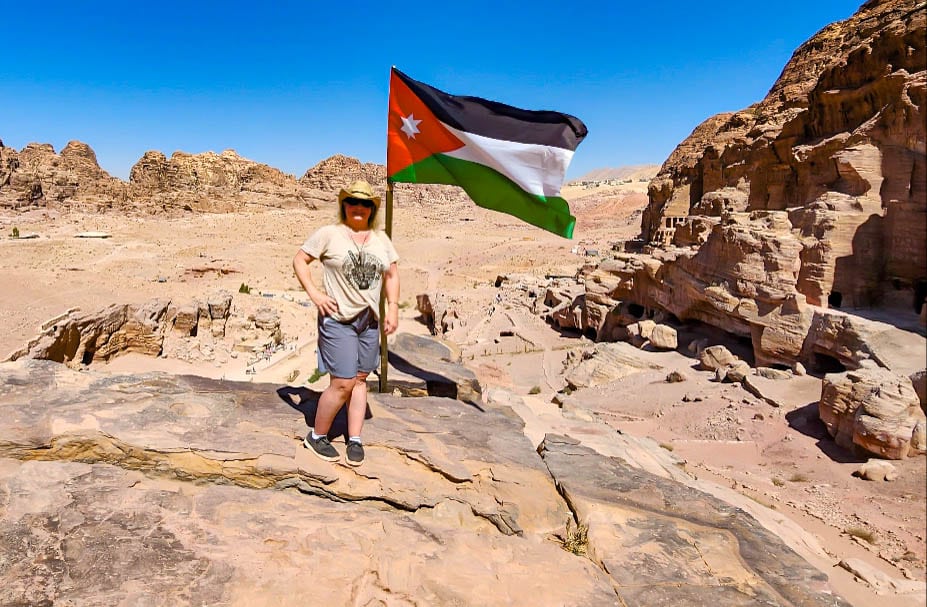
What Can I Find at the Petra Visitor Center / How Do You Find the Best Petra Tour Guides?
The Visitor Center sells tickets and provides information to visitors. It has brochures introducing Petra and its various monuments and maps of Petra, including an aerial view map and a physical relief of the area. This information is also presented in kiosks and displays around the center.
You can book licensed tour guides from the Visitor Center to take you through the site. Guides are suggested when you leave the main trail and are required for more challenging trips, like Aaron’s Tomb. A good local guide will not only make the ancient Nabatean city come to life but will introduce you to the modern B’doul Bedouin, whose culture is inextricably linked to Petra.
Another item to note about the Visitor Center is that there’s free Wi-Fi here. If you don’t have a data plan, this is the perfect place to load our interactive maps so you’ll have them while you’re walking around. I had an in-country data plan and found connectivity in several places within Petra, especially in the higher places such as the Monastery.
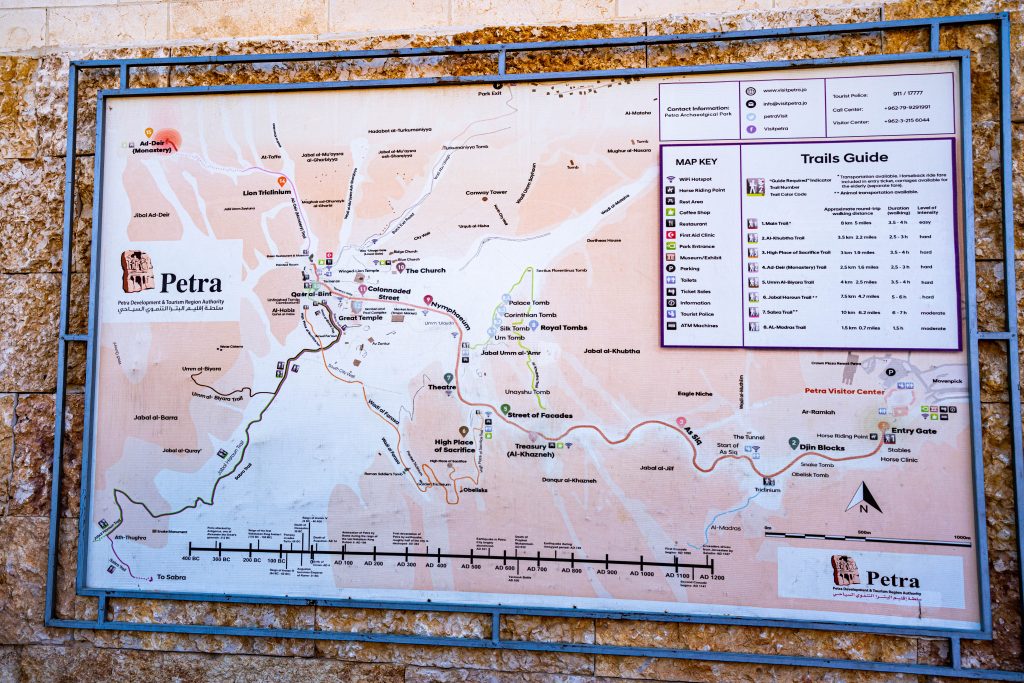

What Are the Must-See Attractions in Petra
The Treasury, or Al Khazna, is the most famous attraction in Petra. It’s nearly 130′ tall and intricately carved from the walls of the Siq, but there’s so much more to see in Petra. The Main Trail runs about 2.5 miles from the Visitor Center to the end of Colonnaded Street near the Great Temple.
Attractions along the Main Trail in Petra include:
- The Siq – A slot canyon controlling the entrance to Petra
- The Treasury (Al Khazna) – A ornately carved building of unknown purpose
- The Tomb of Anensho – Anesho was the Minister of Queen Nabatiyeh Shaqilh II, who ruled between 70and 76 CE
- The Nabatean Theatre – A 4,000-seat theatre carved into the mountain during the reign of King Aretas IV (4BCE-CE 27)
- The Great Temple – One of the major archaeological and architectural components of central Petra
- The Temple of the Winged Lions – A temple dedicated to the Nabataean female ‘Allat (the goddess), also referred to in Petra as al-‘Uzza (the most powerful)
Beyond the Main Trail, several trails lead from the valley floor to historical sites on the canyon rim. In many places along these trails, you’ll find two-thousand-year-old steps carved into the stone with tombs and monuments along the route.
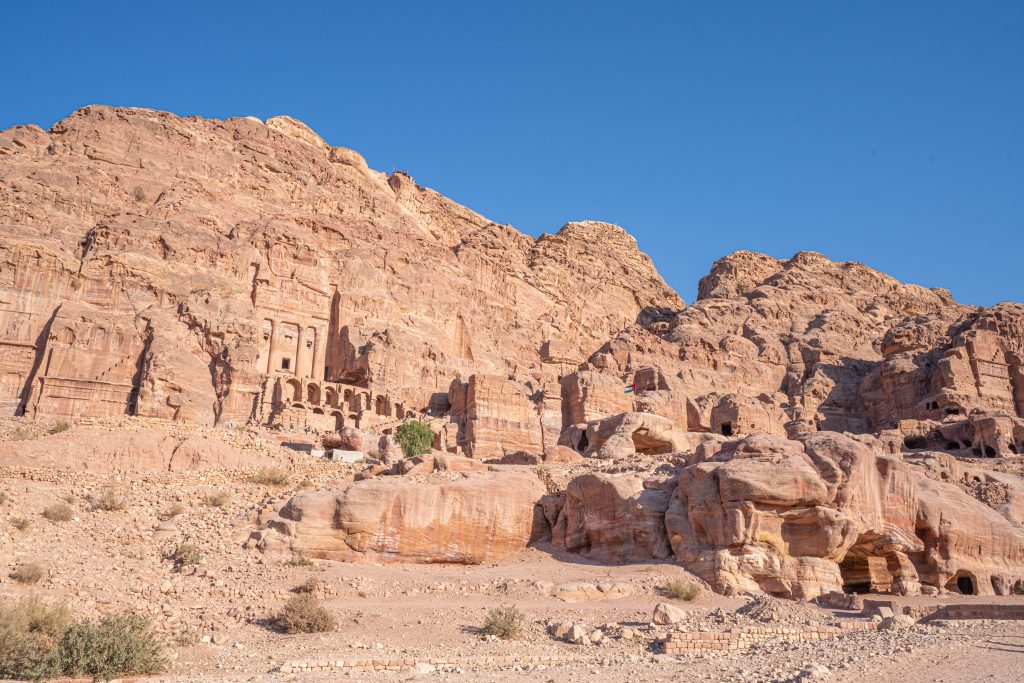
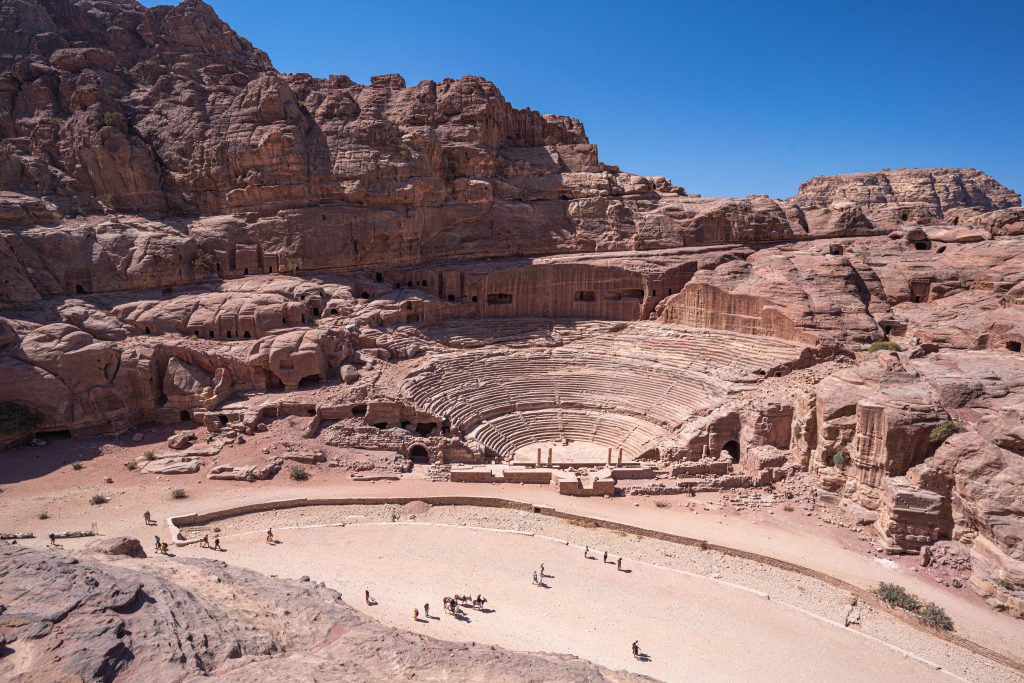
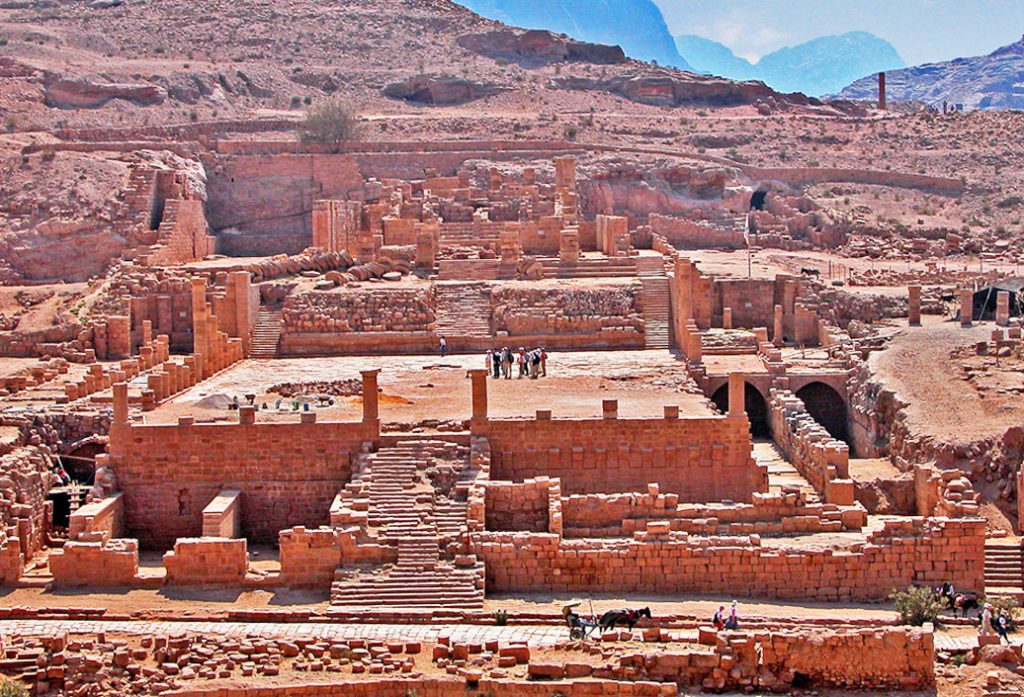
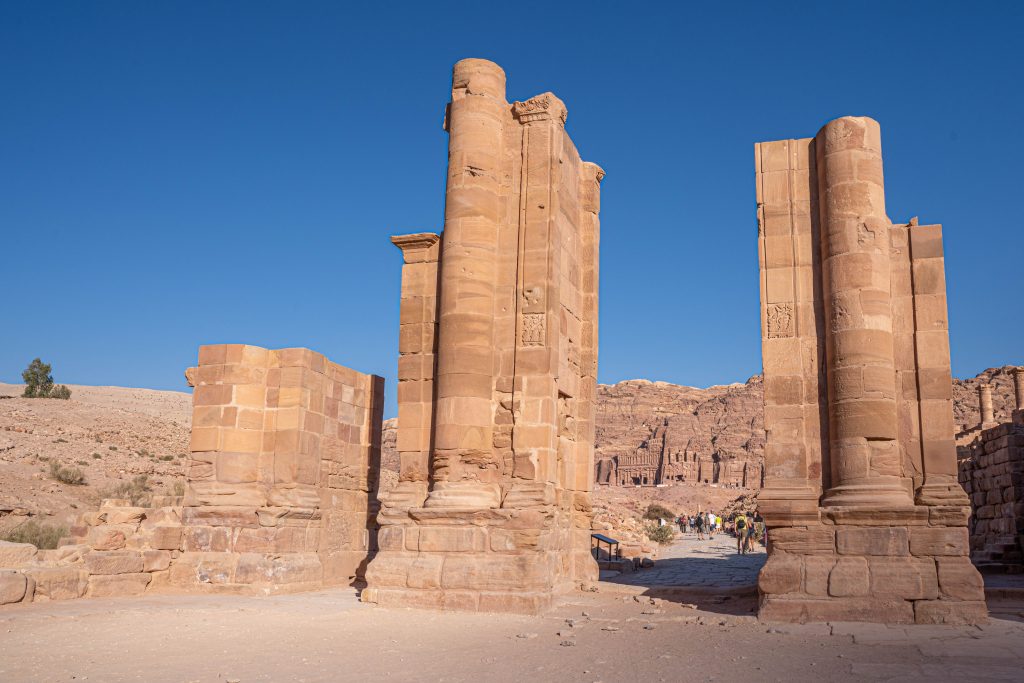
Attractions beyond the main trail include:
- The Monastery (Ad Deir) – A spectacular building carved in relief. The second most commonly visited monument in Petra, after the Treasury
- The Royal Tombs – A series of large mausoleums with impressive facades, including the Urn Tomb, Silk Tomb, Corinthian Tomb, Palace Tomb, and Tomb of Sextius Florentinus
- The Farsa Valley – A pilgrimage route to the High Place of Sacrifice with tombs and monuments along the way, including: the Renaissance Tomb, Tomb of the Soldier, Garden Temple, Lion Fountain, and the Zib Attuf Obelisks
- High Place of Sacrifice – A sacrificial altar on a hilltop overlooking the Nabatean Theatre
- Tomb of High Priest Aaron – The supposed burial place of Moses’ brother, Aaron, according to Jewish, Christian, and local Muslim traditions
We put these attractions (and trails) onto an interactive Petra Map (below). You can download this map by expanding it while you’re on your cell phone (upper right corner), and then you can track your position in real time. We constructed the map with native Google pins with crowd-sourced reviews and pictures, so take a little time to click around and explore, we promise it’s worth it😉🤩.
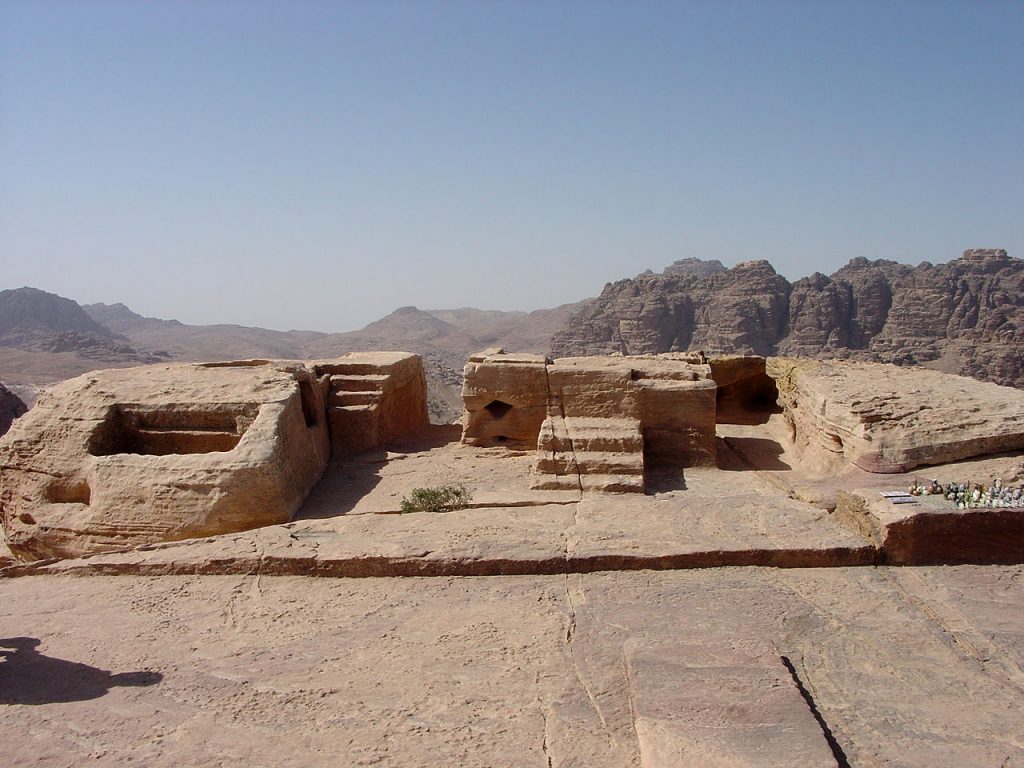
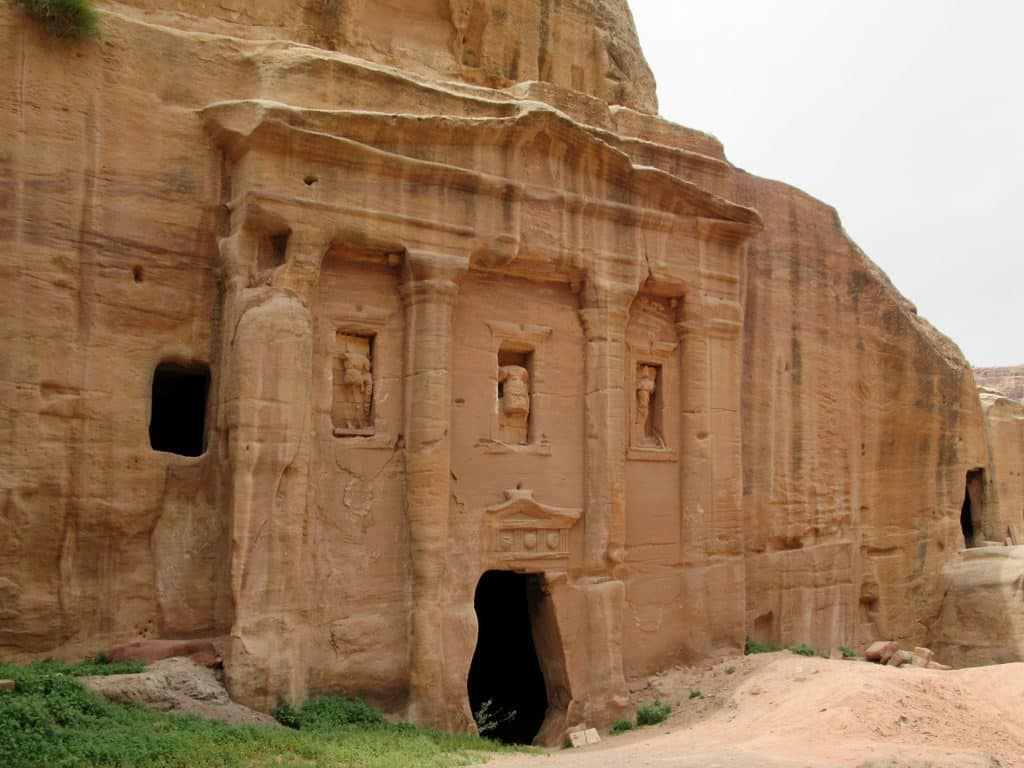
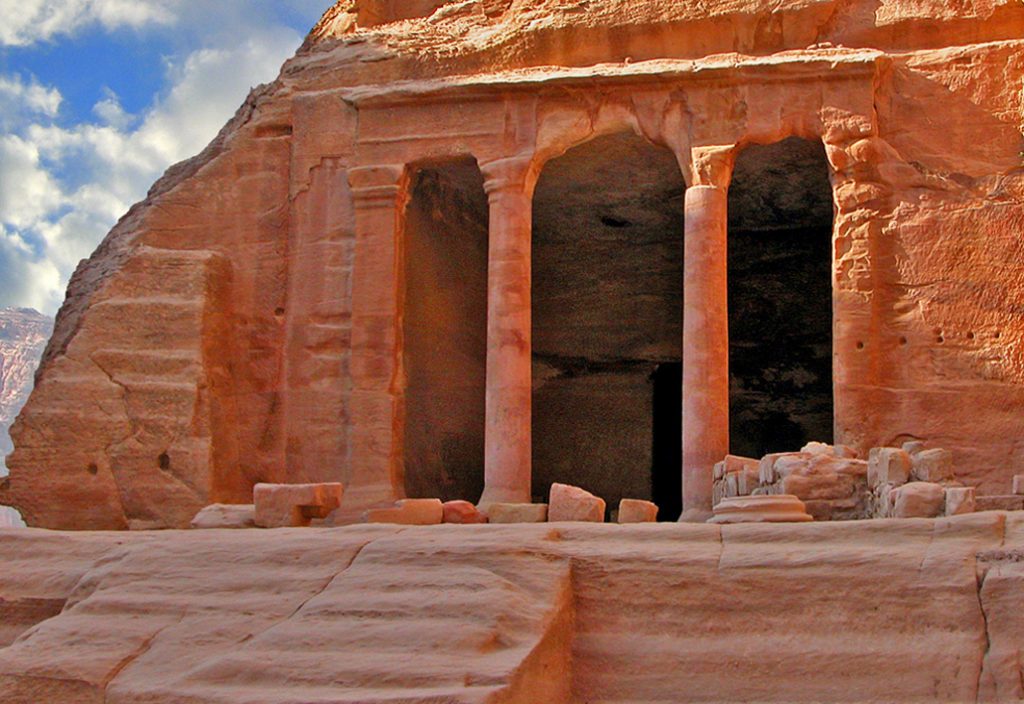
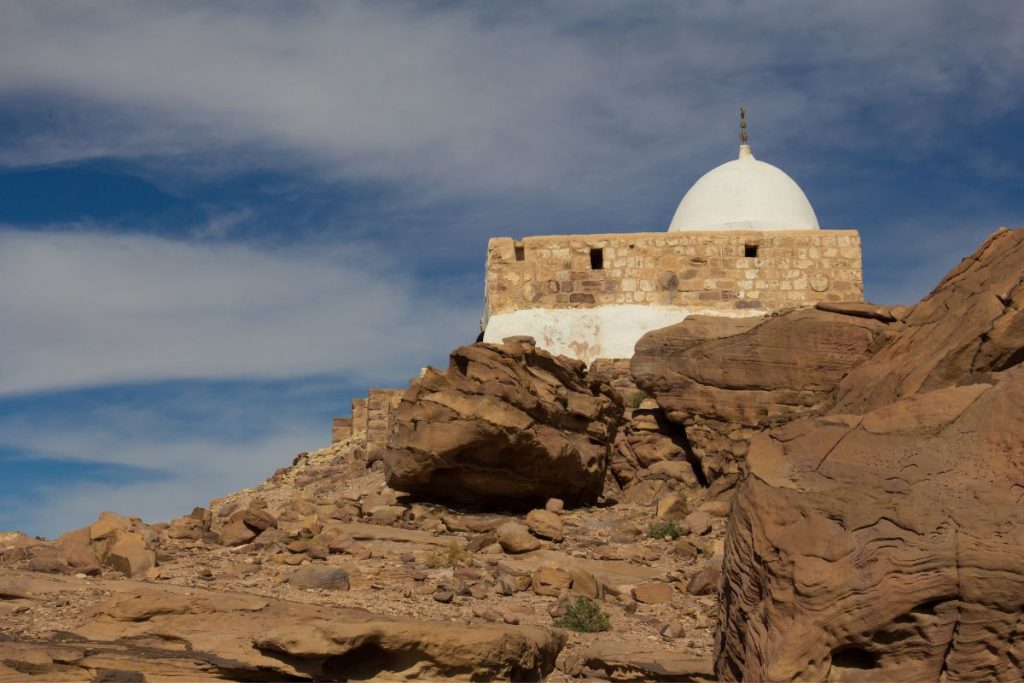
How Long is the Siq?
The Siq is 1.25 miles from the Visitor Center to the Treasury. However, the Siq proper is a 250′ deep canyon you enter at the base, which takes you the final 3/4 miles to the Treasury. All along the Siq, you’ll see evidence of the Nabatean water system that was essential to maintain a city of this size in the desert. It was so meticulously constructed that the Romans did not improve upon it during their occupation.
An earthquake in 363 CE damaged the Siq so extensively that the city never recovered, which showed its value to the ancient citizens of Petra. However, modern visitors need to know that 2.5 miles of walking the Siq (both in and out) will be part of any Petra visit.
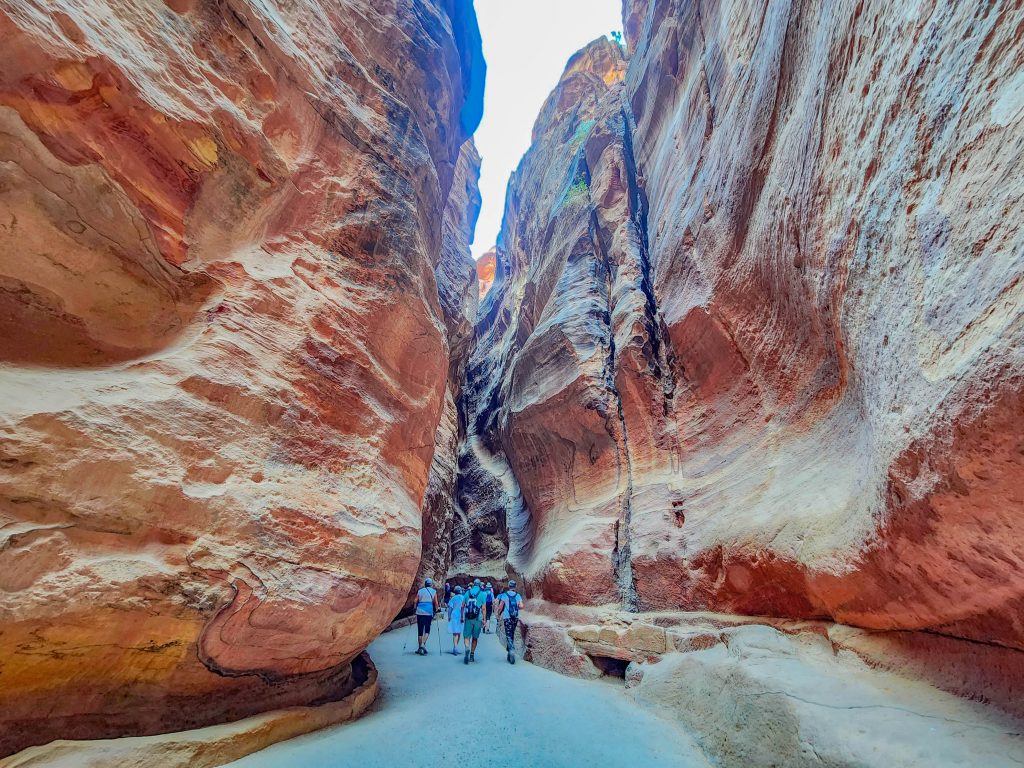
How Hard is it to Hike to the Monastery?
Hiking to the Monastery from the Visitor Center involves hiking the 3-mile long Main Trail (Siq, Street of Facades, Colonnaded Street) to the base of a hill and then climbing up on the Al-Deir Trail. It’s only a mile up the Al-Deir Trail, but you gain about 650′ of elevation along the way. Plus, there are about 850 steps carved into the mountain, worn after thousands of years of use and weather.
In total, it’s an 8-mile hike out and back to the Monastery with 650′ of gain on 850 stairs. That’s a moderate hike by most standards, but it can be difficult with crowds and the desert heat. There are food vendors along the way, particularly at the top and bottom of the hill, and it’s possible to arrange a mule ride, although most people walk. Also, if you have the energy and ambition, there’s a beautiful .3-mile trail at the top to an overlook that I titled the End of the World Spur.
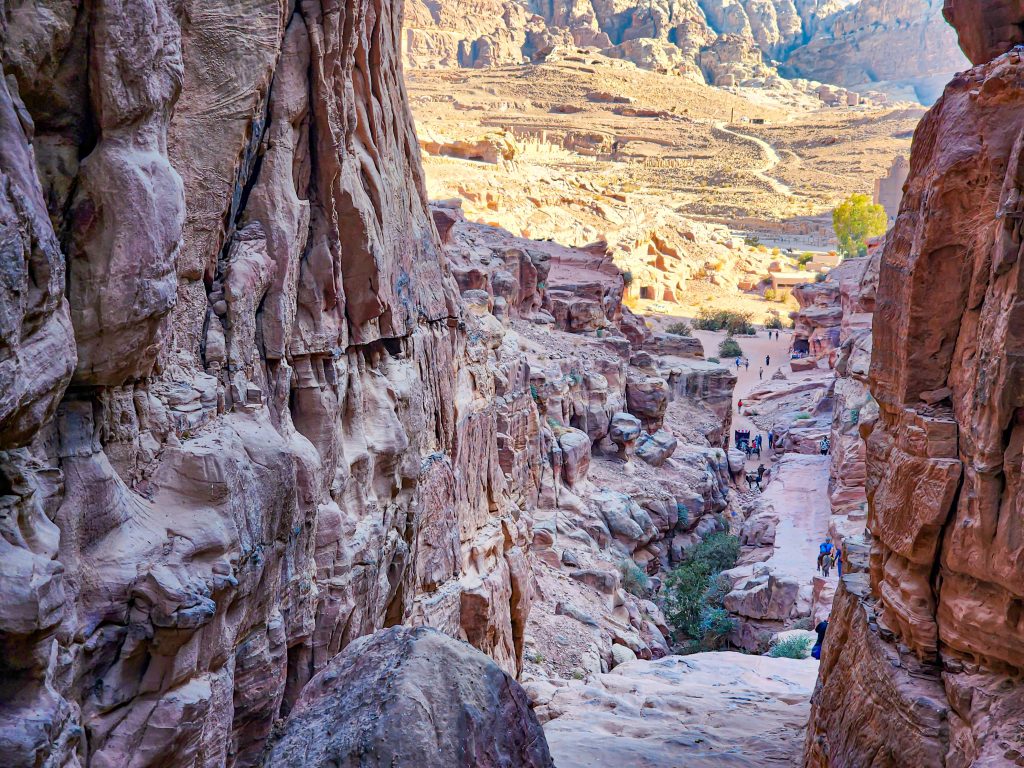

How Much Walking is There in Petra
Long story short, there’s a lot of hiking in Petra. You’re expected to hike from the Visitor Center through the Siq and then between the monuments on a series of trails.
There are ten primary trails in Petra, and we’ve already covered five of them (Siq, Street of Facades, Colonnaded Street, Al-Deir, End of the World) in the previous section on hiking to the Monastery. Those are the primary hiking trails in Petra, but there are three common side trails as well.
The Palace Tomb Trail is the most frequently visited side trail that takes you to the Palace Tomb complex. It’s .35 miles long and connects to the Al-Khubtha Trail (.57 mi), which takes you to an impressive overlook of the Treasury.
Another popular side trail is the Farsa Valley Loop (2 mi) which takes you to the High Place of Sacrifice Spur (.2 mi). This loop bypasses the Colonnaded Street and the Street of Facades and lets you see the Farsa Valley tomb complex and the High Place of Sacrifice.
The third trail is the route to Aaron’s Tomb (3.1 mi), which is quite difficult and requires a guide. Luckily, it’s customary to arrange camels for this trek.
Pro-Tip – Wear comfortable shoes! I was amazed at the comfort of my AllBird Tree Skippers. I was able to spend a full day hiking (with 2 artificial knees and low-back issues) without pain or foot/knee discomfort
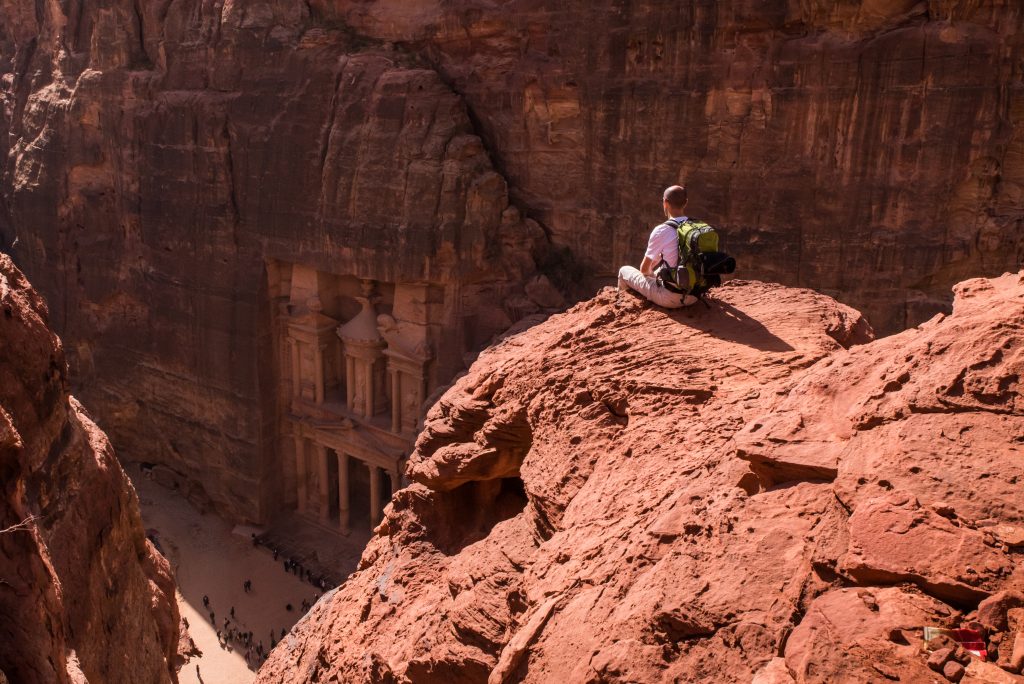
Trails in Petra:
- The Siq (1.25 mi, Flat) – Runs between the Visitor Center and the Treasury
- Street of Facades (.75 mi, flat) – 1/2 of the main drag in Petra from the Treasury to Nymphaeum
- Colonnaded St (.4 mi, flat) – The other half of the main drag in Petra from the Nymphaeum to the Winged Lion Temple
- Al-Deir Trail (1 mi, 800′) – Access the Monastery from the end of the Colonnaded St
- End of the World spur (.3 mi, 50′) – Spur trail from the Monastery to the End of the World Overlook
- Palace Tomb Trail (.35 mi 200′) – Access the Palace Tomb Complex from the Street of Facades
- Al-Khubtha Trail (.56 mi, 600′) – Continues from the Palace Tomb Trail to a spectacular Treasury overlook
- Farsa Valley Loop (2 mi, 800′) – Accesses to the High Place of Sacrifice and Farsa Valley tomb complex and bypasses the Colonnaded Street and Street of Facades
- High Place of Sacrifice Spur (.2 mi, flat) – Spur trail to the altar from the Farsa Valley Loop
- Aaron Tomb Trail (3.1 mi, 1000′) – A trail to Aaron’s Tomb from the Farsa Valley Loop, which requires a guide
Pro tip: Download AllTrails+ for a one-stop shop app for planning all of your hiking, biking, and camping adventures.
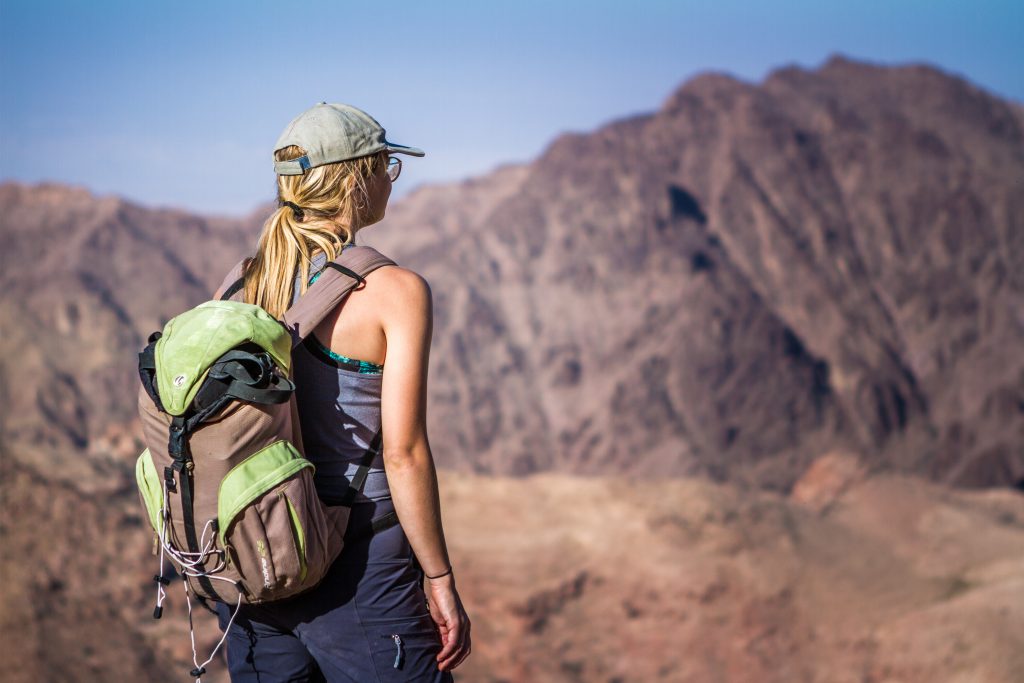
Can I See Petra in One Day? (aka The Perfect 1-day Petra Itinerary)
Most people spend two days in Petra, but If you’re going to see Petra in a day, you must start early. The park opens at 6:00 AM. Stop and explore the Treasury right away before the crowds arrive, and then make a beeline for the Monastery. This lets you see the two most popular (and photogenic) monuments without the crowds and avoids congestion on the Al-Deir Trail.
You will have hiked about 5 miles by the time you’ve come back down their Al-Deir Trail, so it’s the perfect time to stop for a snack and cup of tea at the restaurants at the base of the hill.
The time should be roughly 10:00 when you get up and move again, and before the full heat of the day, so it’s a good time to climb to the High Place of Sacrifice. It’s better to hike the Farsa Valley Loop clockwise, starting from the theatre, because it’s easier to climb stairs and walk down the trail. Plus, it lets you get the climb done earlier and explore the Farsa Valley tombs on the way down.
It will be lunchtime when you get down Farsa Valley from the High Place of Sacrifice. It will also be your third pass through Colonnaded Street and Street Facades, aka the main drag. By now, you should know which monuments interest you and where you’d want to eat lunch. This is the time to thoroughly explore the main drag and grab a bite to eat.
You have one more side trail to explore before leaving Petra – the Royal Tombs. It’s a relatively short hike up to the tombs, but if you’re feeling motivated and don’t mind the heat, you can continue on the Al-Khubtha Trail to the Treasury Overlook.
You’ll want to visit the Nabatean Theatre and Tomb of Anesho after the Royal Tombs and continue out the Siq to the Visitor Center. This one-day Petra itinerary had over 12 miles of hiking with 2500′ of gain. You can still return for the Petra at Night show later that day, but Aaron’s Tomb will have to wait. Depending on your schedule (and motivation), you can do activities around Petra, like the Turkish Baths and Little Petra, the following morning without re-entering the site and re-hiking the Siq.
You can turn this into a two-day itinerary by saving the Farsa Valley Loop and Palace Tombs for the second day. I’d save Aaron’s Tomb for my third day in Petra. Adding extra days also lets you explore things to do around Petra too.
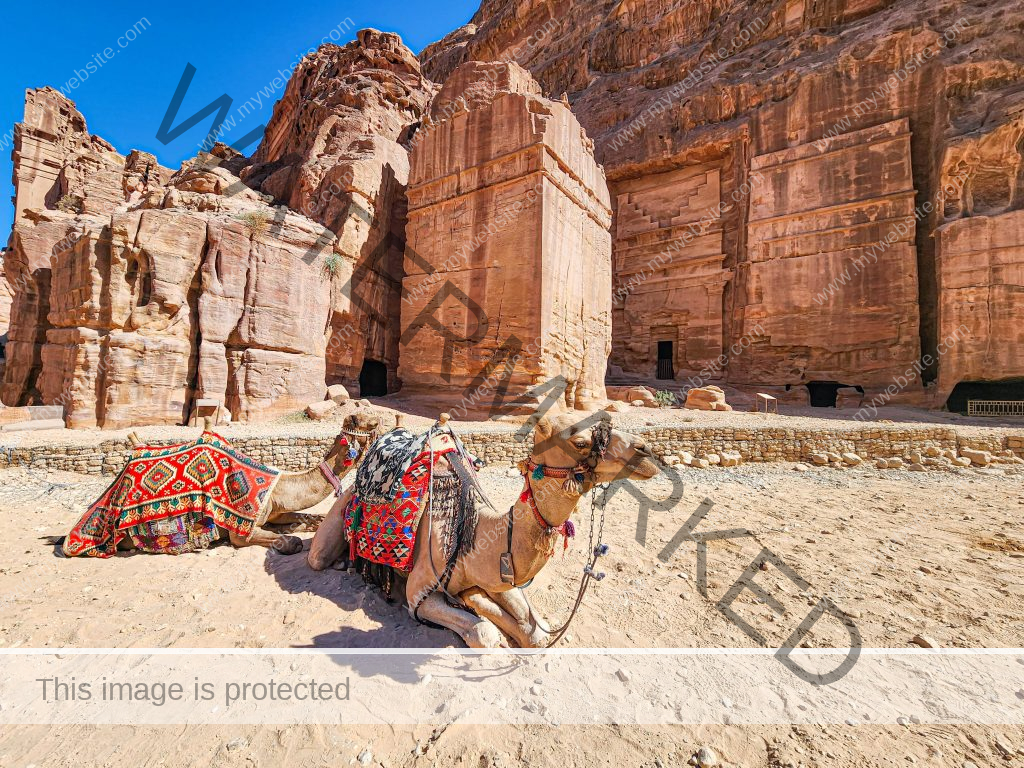
Is Petra at Night Worth it?
Petra is one of the Seven Wonders of the Modern World, and you get to see it in a whole new light. I would definitely say yes- Petra at Night is worth it.
The trip through the Siq is a top-notch night hike. The path is easy to follow, and the interplay between the shadows of the canyon walls and a sliver of stars overhead is super cool. Once you get to the Treasury, you’re greeted with thousands of candles and a Bedouin flute serenade. The performance is subdued, but you’re here for the lighting and ambiance.
You’ll want to arrive early at the visitor center (~8:00), so you can queue up for a good view, but the experience is transformative.
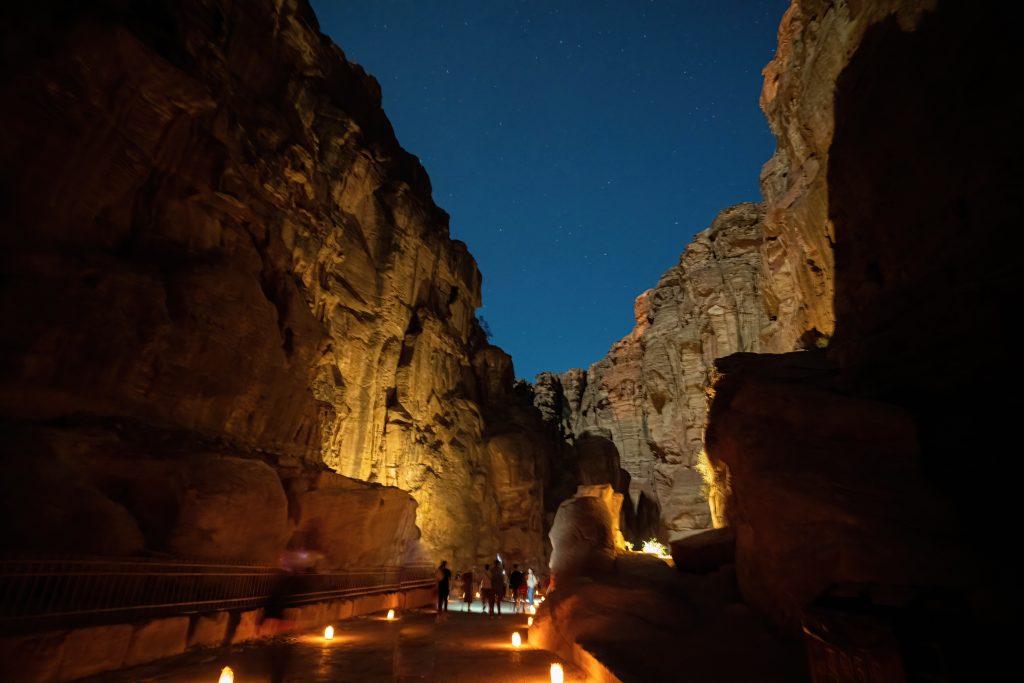
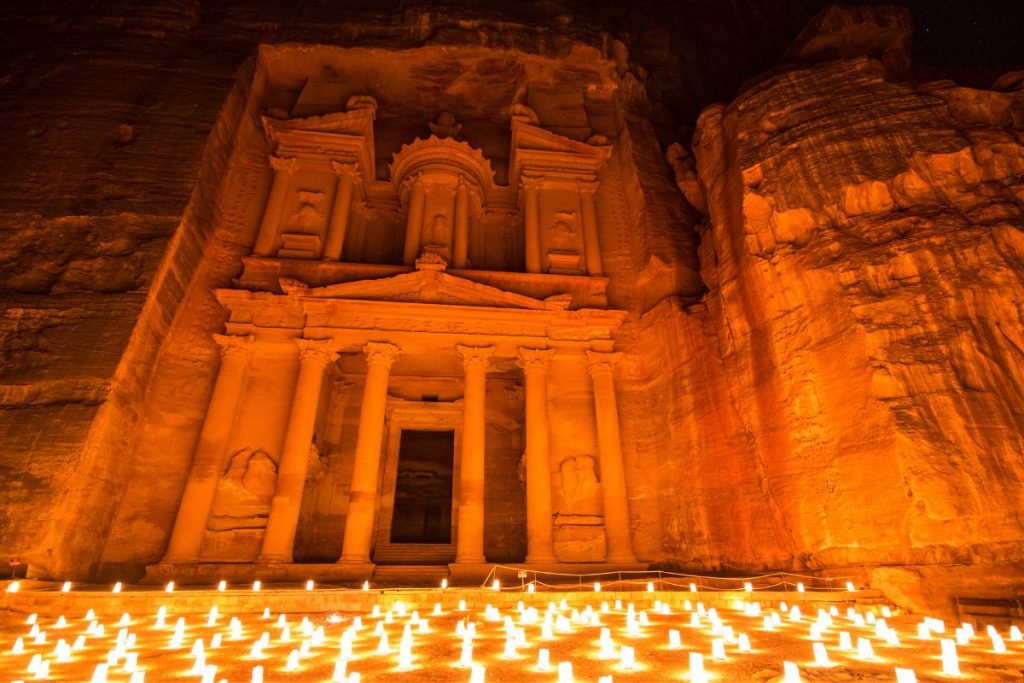
How to Take the Best Petra Pictures?
You’re generally fighting two things with Petra pictures – crowds and Dynamic range – the ratio between the brightest and darkest parts of an image, from pure black to brightest white. That is to say, parts of your picture will be blown out while you’ll miss the texture and colors of Petra’s sandstone monuments. Since Petra closes down before the evening golden hour, your best bet is to arrive early, where you’ll beat the heat and the crowds and have the best lighting. Photograph the Treasury on the way in and make a beeline to the Monastery.
On the way back, look for sweeping landscapes and macro shots that you might have missed. Also, look for ways to use framing to eliminate hot spots and people. For example, how many pictures of the Treasury have you seen framed through the opening of the Siq? This lets you shoot from shadows into light and use the Siq’s walls to block out people in the scene.
Also, don’t be afraid to ask the locals to help you with a shot, and be sure to tip when you do. The Bedouin men are dashing, often times with animals and local clothes that add artistic elements to your picture. Bedouin women, on the other hand, are often shy so you’ll want to ask permission before photographing as a matter of respect. Also, these are the caretakers of Petra, and they know shots and angles that you might not have seen or thought of. This philosophy goes all the way to specific Petra photography tours, where you’ll work with local guides to get the best shots of Petra.
For Petra at Night, arrive early and wait at the front of the line with your camera ready. You’ll arrive at the Treasury with the candles lit and need to shoot quickly before everybody takes their seats. We’ve heard photography tours help with Petra at Night too, but we haven’t confirmed that information.
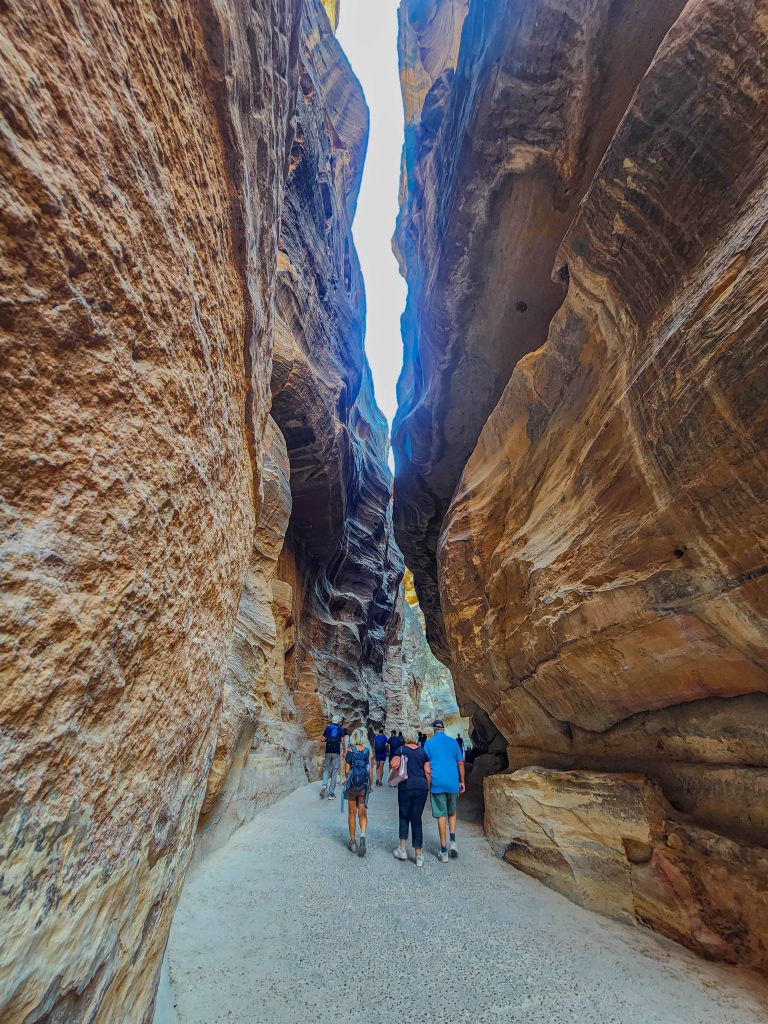
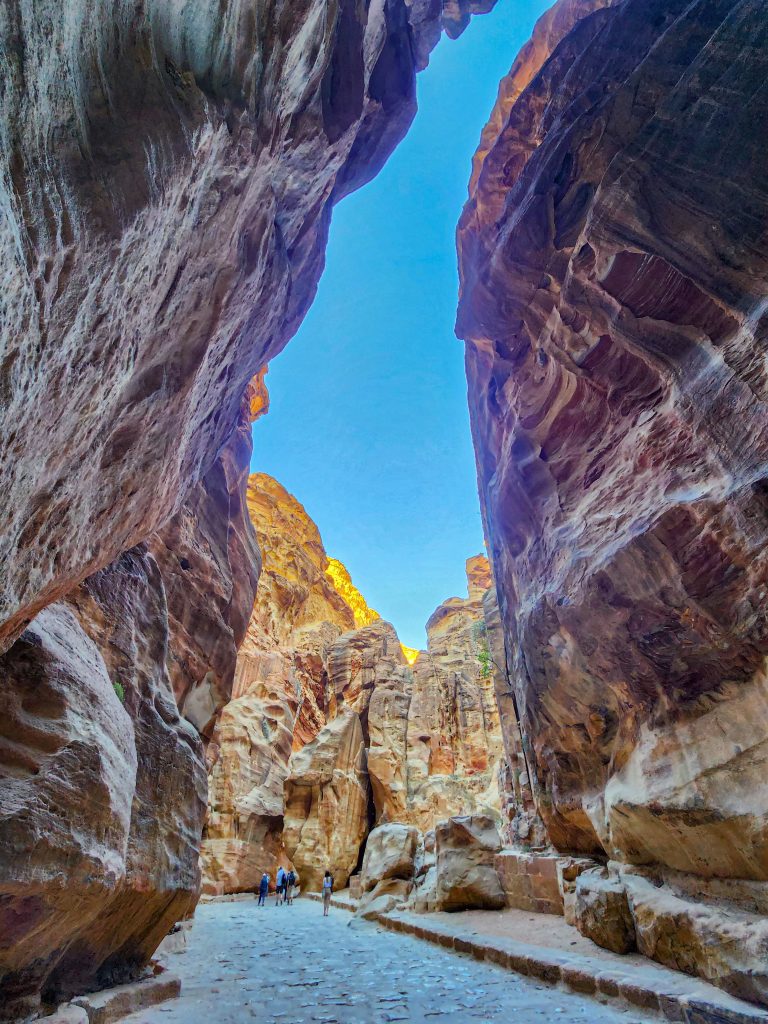
What Can I Do Around Petra?
The town outside of Petra is called Wadi Musa. It’s good to have a couple of things to do around Petra lined up to flesh out multi-day itineraries and fill in gaps on travel days. If you’re spending only a 1/2 day in Petra, that’s barely enough time to hike down the Siq and back.
Things to do around Petra:
- Little Petra – An archeological site with cave dwellings dating back to the Neolithic Period
- Petra Museum – 20,000 sq ft of climate-controlled galleries with 300 objects from Jordan’s Department of Antiquities
- Petra Kitchen – Nightly cooking classes and dinners focusing on authentic local cuisine
- Turkish Baths – Sweat, scrub, and soak in a traditional spa
- Shopping – You’ll find a large collection of shops around the Visitor Center
- Shobak Castle – Montreal – Ruins of a 12th-century crusader castle
- Zara Spa – An upscale spa inside the Mövenpick Petra with Jordanian scenography
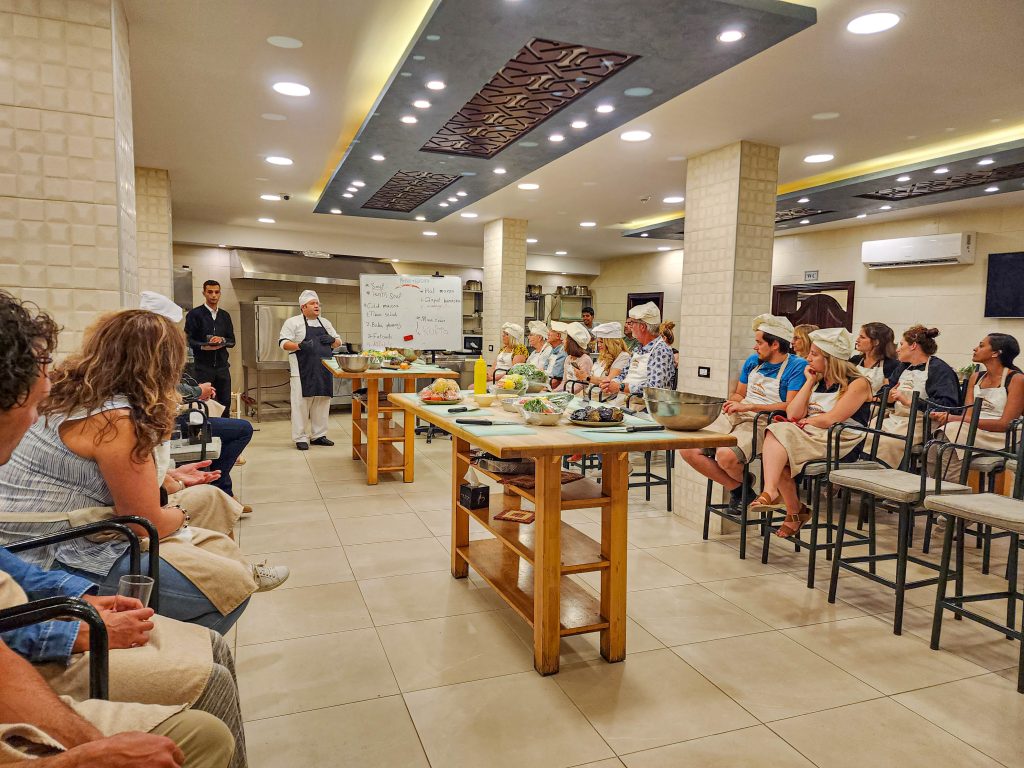

How is Little Petra Different from Petra?
Like Petra, Little Petra (Siq al-Barid) is a Nabataean site with buildings carved into the walls of the sandstone canyons. As its name suggests, it’s like Petra but smaller. It has three open areas connected by a 1,480 ft canyon. Little Petra is part of the Petra Archeological Park but accessed separately.
Tourists often visit it in conjunction with Petra since it is free and usually less crowded. You also don’t have the 1.5-mile entrance hike through the Siq to contend with, so Little Petra is much easier to work into a half-day itinerary. One of our favorite stops was “The Painted House” with interior art depicting grapes, vines, and putti in great detail with a varied palette, probably in homage to the Greek god Dionysus and the consumption of wine.
Just around the corner from Little Petra is another archeological site called Al Beidha. It’s one of the earliest villages with habitation between 7200 and 6500 BC. The site has stone masonry and a wall around the settlement of round houses with subterranean floors.

There is a Five-Star Hotel at the Gateway to Petra
We found the Mövenpick Petra while doing research for our 13-day Luxury Jordan Itinerary. It’s a beautiful property with unparalleled access to the Petra Visitor Center. It’s also a perfect home base for your Petra adventures, with rooftop dining, swimming pools, and a daily chocolate hour.
The Mövenpick Petra is also home to the Zara Spa, one of our favorite spas from the entire luxury Jordanian itinerary. The spa’s rock construction is reminiscent of a Neolithic temple, and you’ll find signature treatments based on the scenography of the Jordanian desert. Natural salt scrubs and mineral-rich mud wraps transport you to the shores of the Dead Sea, while essential oils extracted from local plants take you back to the time when Nabatean fragrances and oils were some of the most precious trade commodities in the world.
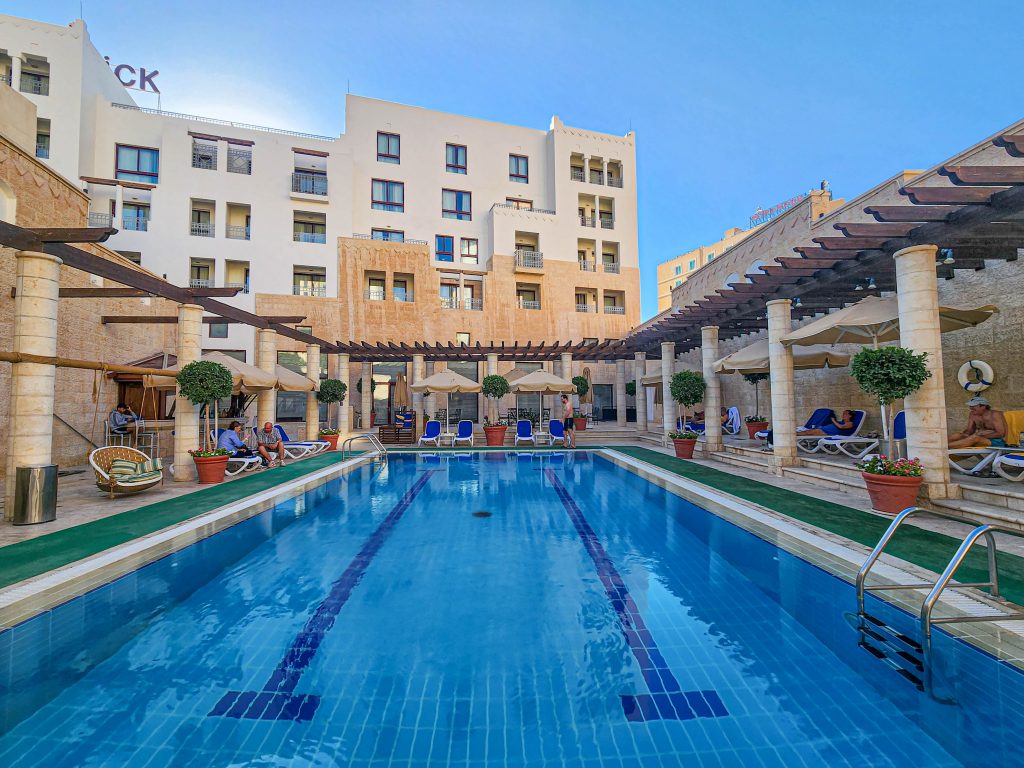
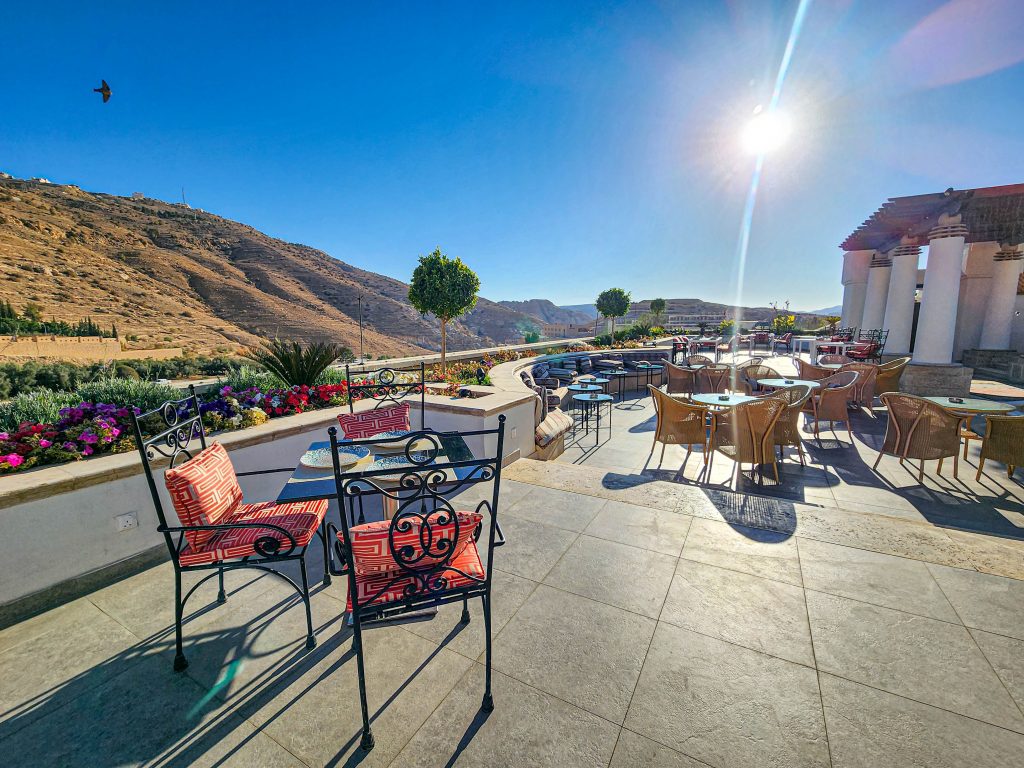
Final Thoughts on Visiting Petra
Visiting Petra is a must-do Jordan adventure. If you have enough time in your itinerary, you could easily spend three days in Petra. However, if needed, you could make it a two-night / one (very full) day activity. There is a lot of hiking in Petra, which you can mitigate by starting early and having a good guide. Also, seriously consider hiring a qualified local guide to bring the history to life and introduce you to the fascinating modern Bedouin culture.
Disclosure: A big thank you to the Jordan Tourism Board for hosting us, setting up a fantastic itinerary, and usage of some of the images throughout (image credit in hover text 😉).
For more travel inspiration check out Jordan Tourism’s Instagram, Facebook, Twitter, and YouTube accounts.
As always, the views and opinions expressed are entirely our own, and we only recommend brands and destinations that we 100% stand behind.
Ready to Book Your Trip? These Links Will Make It Easy:
Airfare:
- Find low fares and book your flight with Expedia, WayAway, CheapOair, or Trip.com
- Grab your airport parking reservation from The Parking Spot
- Stay overnight at an airport hotel and park for free with Park Sleep Fly
- Enjoy your time at the airport at a Priority Pass Lounge
Lodging:
- We loved staying and the beautiful all-inclusive Sandals Royal Curacao and we think you will too! Book your Sandals getaway now!
- From hotels to private homes, find the perfect accommodation with Hotels.com, VRBO, Expedia, or Booking.com.
- You can also book direct through Hilton Hotels
Insurance:
- Protect your trip and yourself with World Nomads and Medjet
- Safeguard your digital information by using a VPN. We love SurfShark as it is superfast for streaming Netflix
- Stay safe on the go and stay connected with an eSim card through AloSIM
Attractions/Activities:
- Save on tickets to attractions, sightseeing tours, and more with Tiqets
- Get Your Guide and Viator for guided tours/excursions, day trips, and activities
- Want to learn a city from the ground up? Take a small group walking tour with Walks – 5-star rated with a Tripadvisor Certificate of Excellence
- Want to book an epic adventure experience with top-notch companies like Intrepid Travel, G-Adventures, or Backroads? Check out Travelstride
- Find information on local trails with the All Trails App.
- Need something else to plan your perfect trip? Visit our Resources Page for more trusted partners
Like it? Pin it for later on Pinterest!
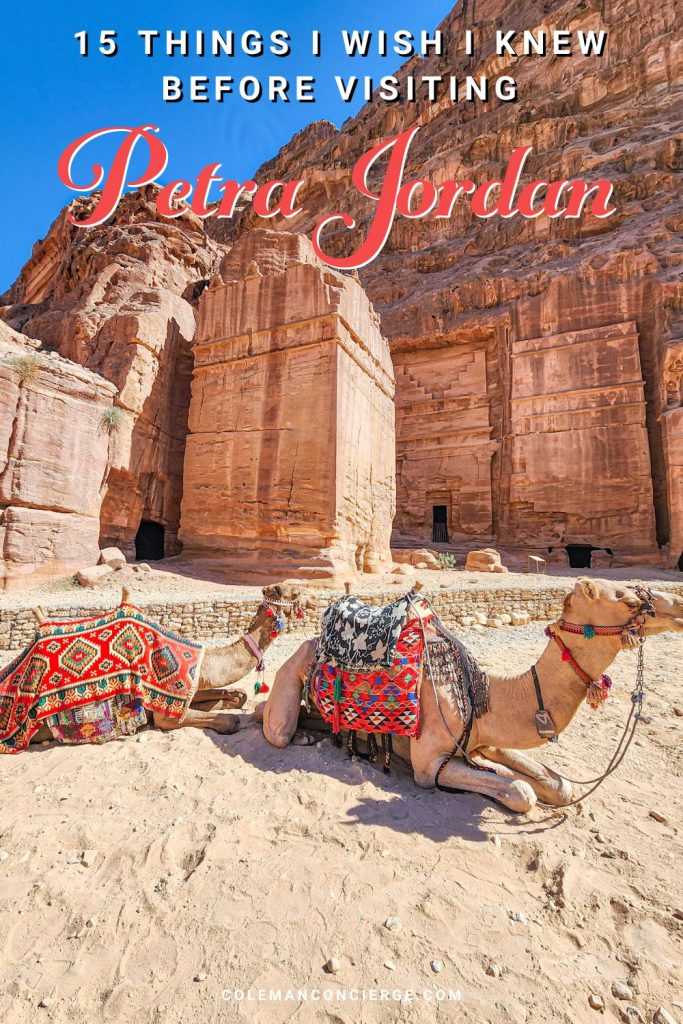
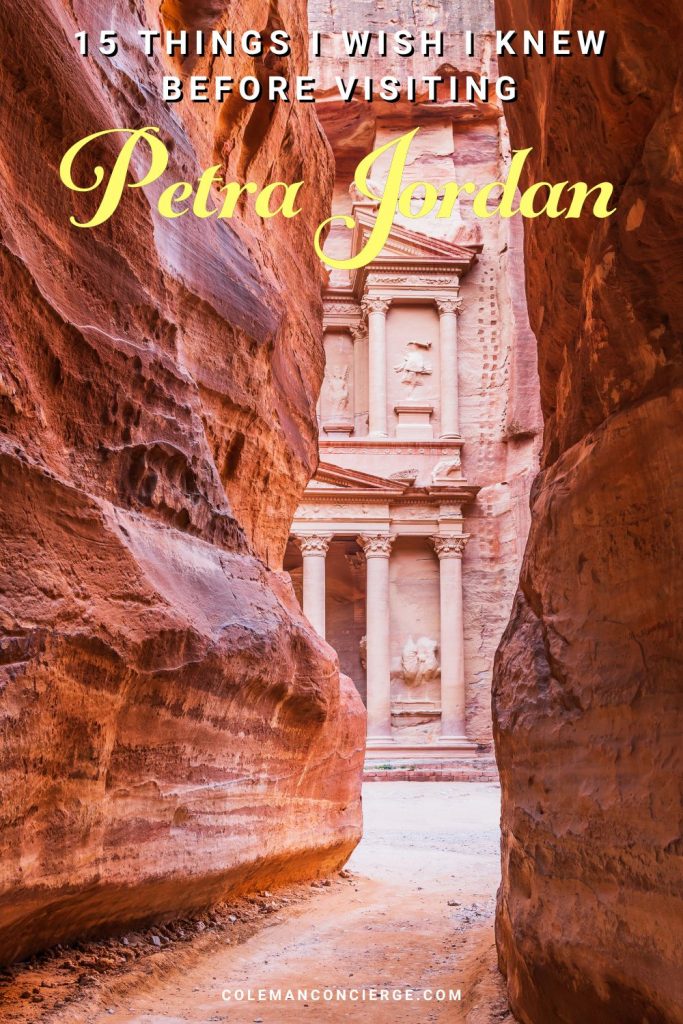

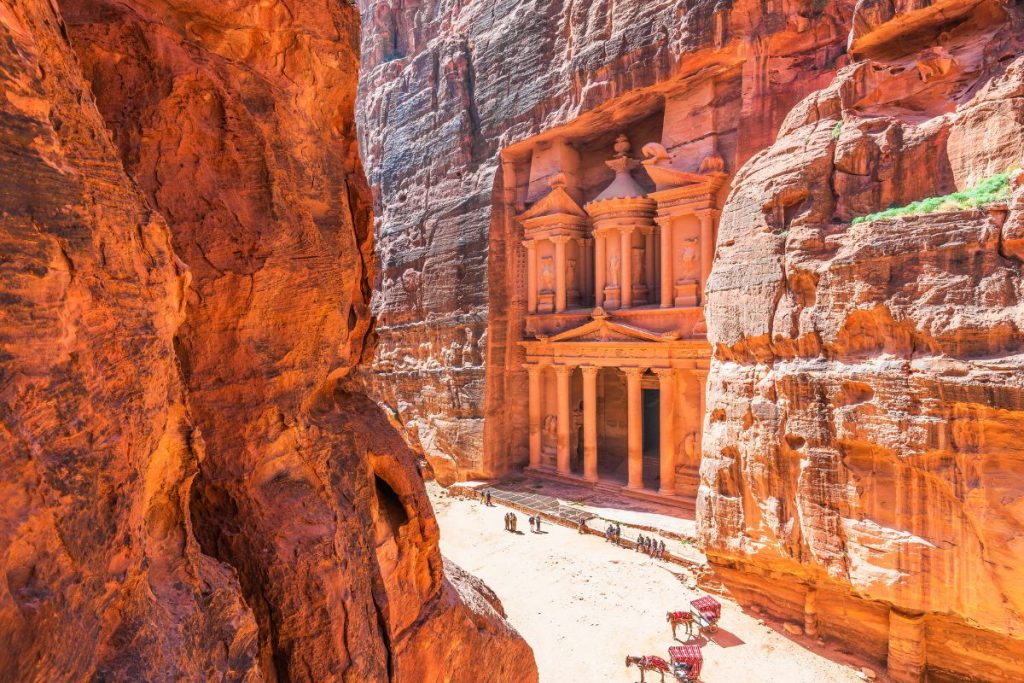
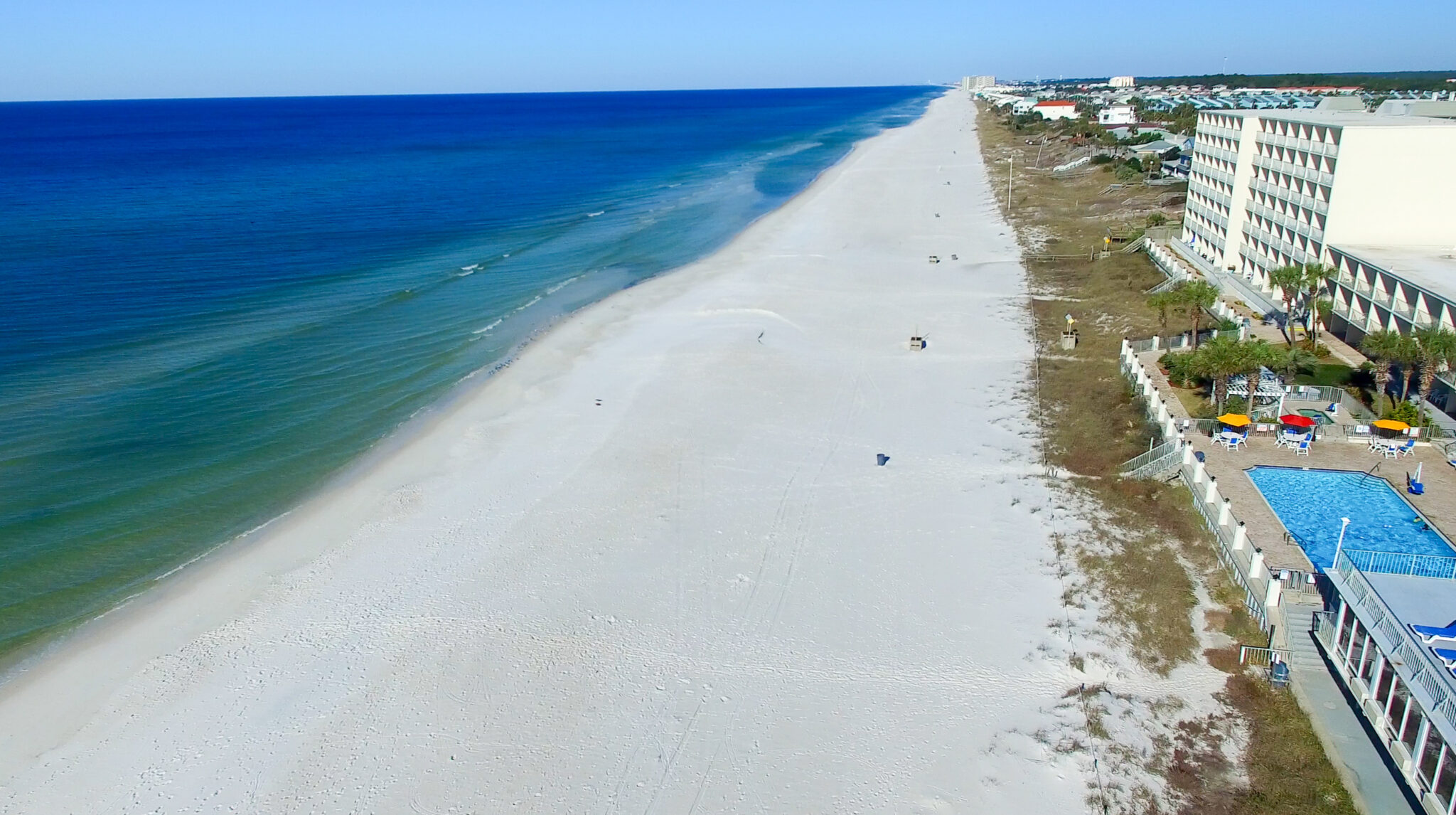
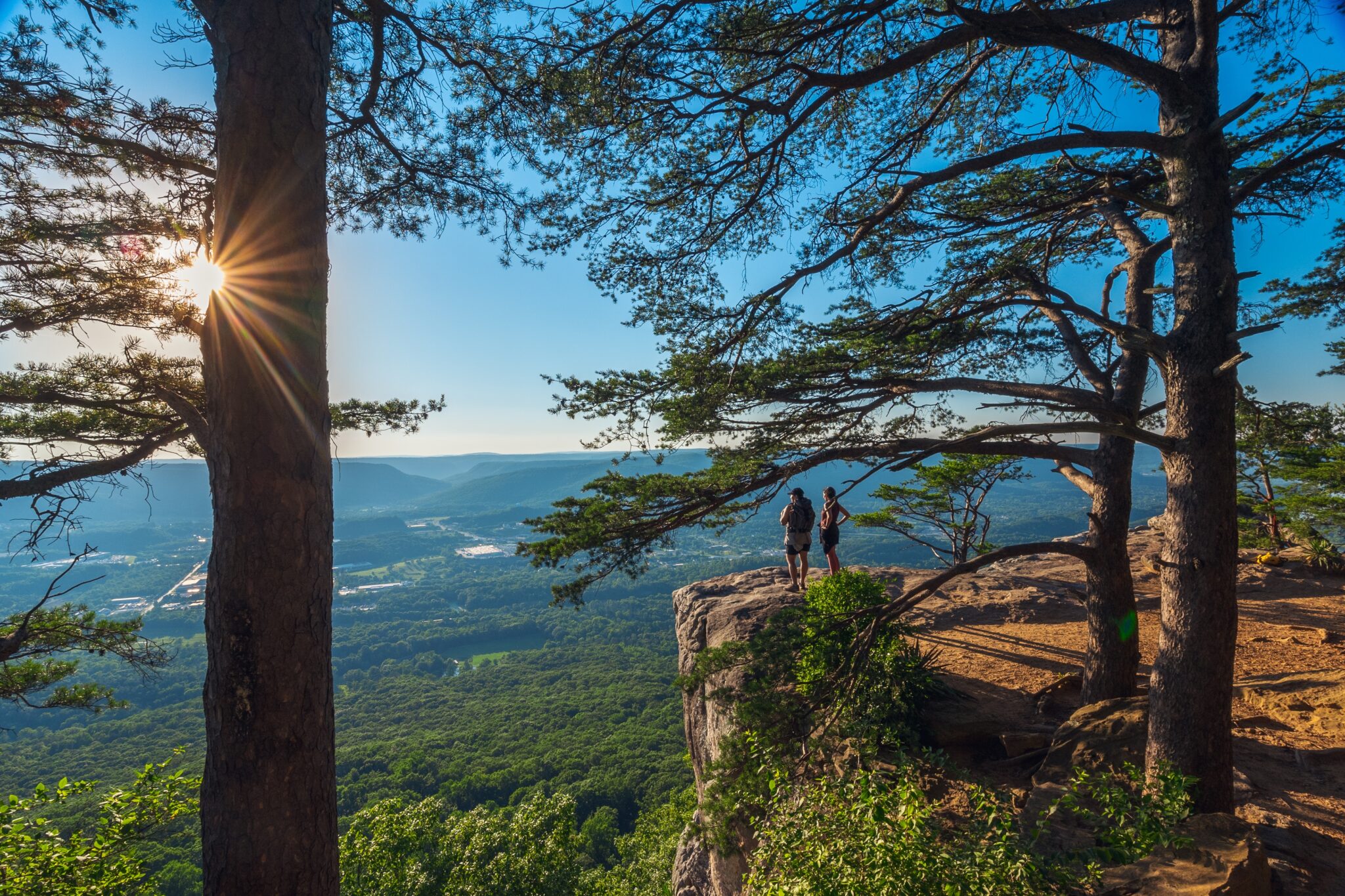
 Hi! We are Jenn and Ed Coleman, and together we are Coleman Concierge. It is our goal to inspire you to get out, expand your world, and to seek adventure, even in your own backyard.
Hi! We are Jenn and Ed Coleman, and together we are Coleman Concierge. It is our goal to inspire you to get out, expand your world, and to seek adventure, even in your own backyard.













3 Responses
I’m notorious for under researching a place and only finding out details upon arrival. Petra was one of those places for us. I wished I had known these distances so we could make better decisions about when to take a cart or donkey to cut down on energy waste. It’s a long day and I could have done it better had I read this before going.
Comments like yours are why we do what we do! Thank you for taking the time!
great post, I been to Petra three times and you defiantly nailed it on the points, will be a great help to anyone going there for the first time